Business and Corporation Law - Contract, Consumer and Implied Terms
VerifiedAdded on 2021/06/16
|10
|2478
|21
Homework Assignment
AI Summary
This assignment explores key concepts in business and corporation law, focusing on contract formation, consumer rights, and implied terms. The first part of the assignment analyzes a scenario involving a painting sale, examining whether a valid contract was formed between the buyer and seller, considering elements like offer, acceptance, and counter-offers, as well as the revocation of offers. The second part delves into consumer law, specifically the Australian Consumer Law (ACL), to determine whether a buyer is entitled to rights under the ACL when purchasing a painting. The analysis considers misleading conduct, product descriptions, and the implications of the seller's actions. The assignment also defines express and implied terms in contracts, differentiating between conditions and warranties, and referencing relevant case law to support the arguments presented. The assignment concludes by applying these legal principles to the provided scenarios, determining the validity of the contract and the consumer's rights.
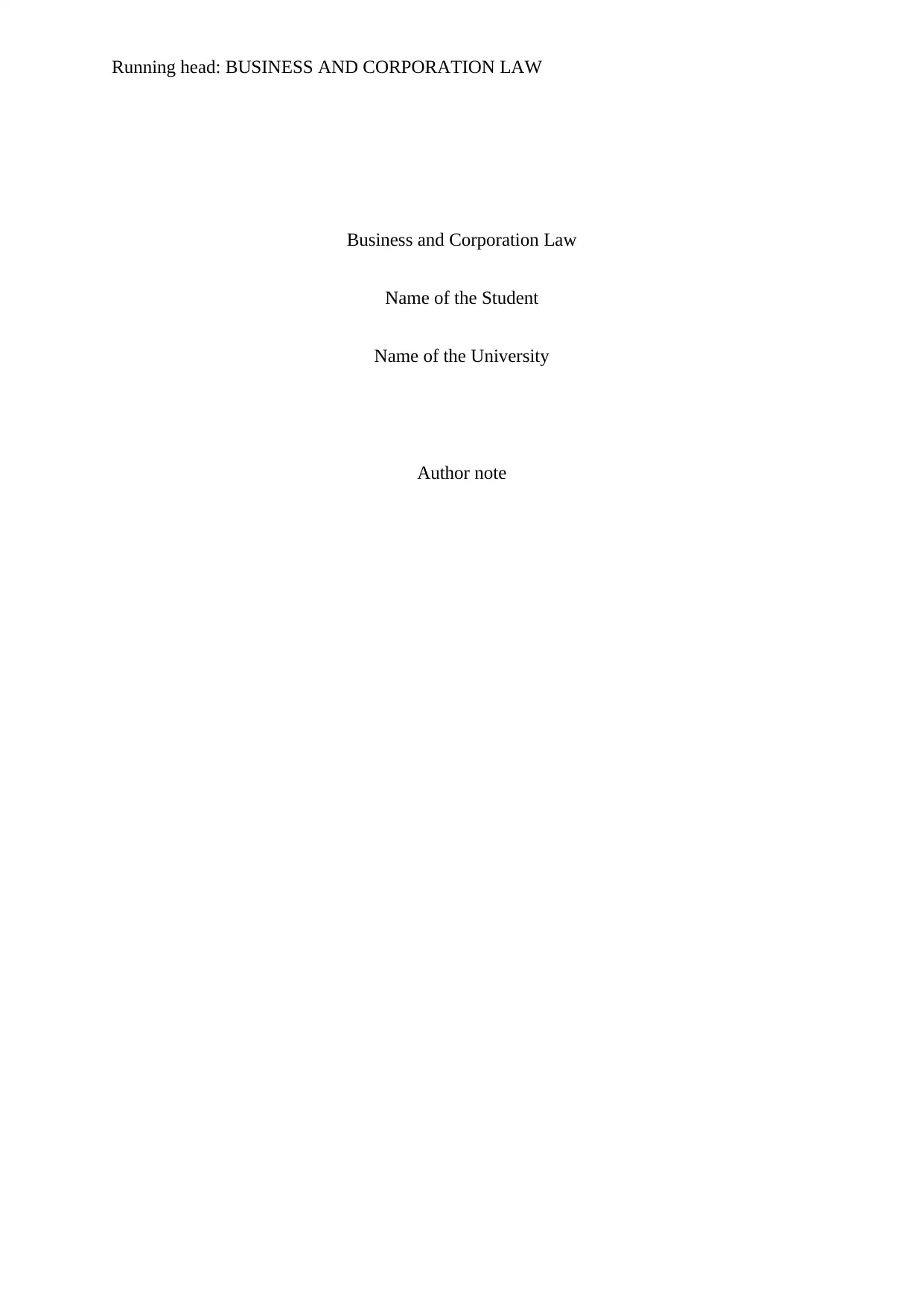
Running head: BUSINESS AND CORPORATION LAW
Business and Corporation Law
Name of the Student
Name of the University
Author note
Business and Corporation Law
Name of the Student
Name of the University
Author note
Paraphrase This Document
Need a fresh take? Get an instant paraphrase of this document with our AI Paraphraser
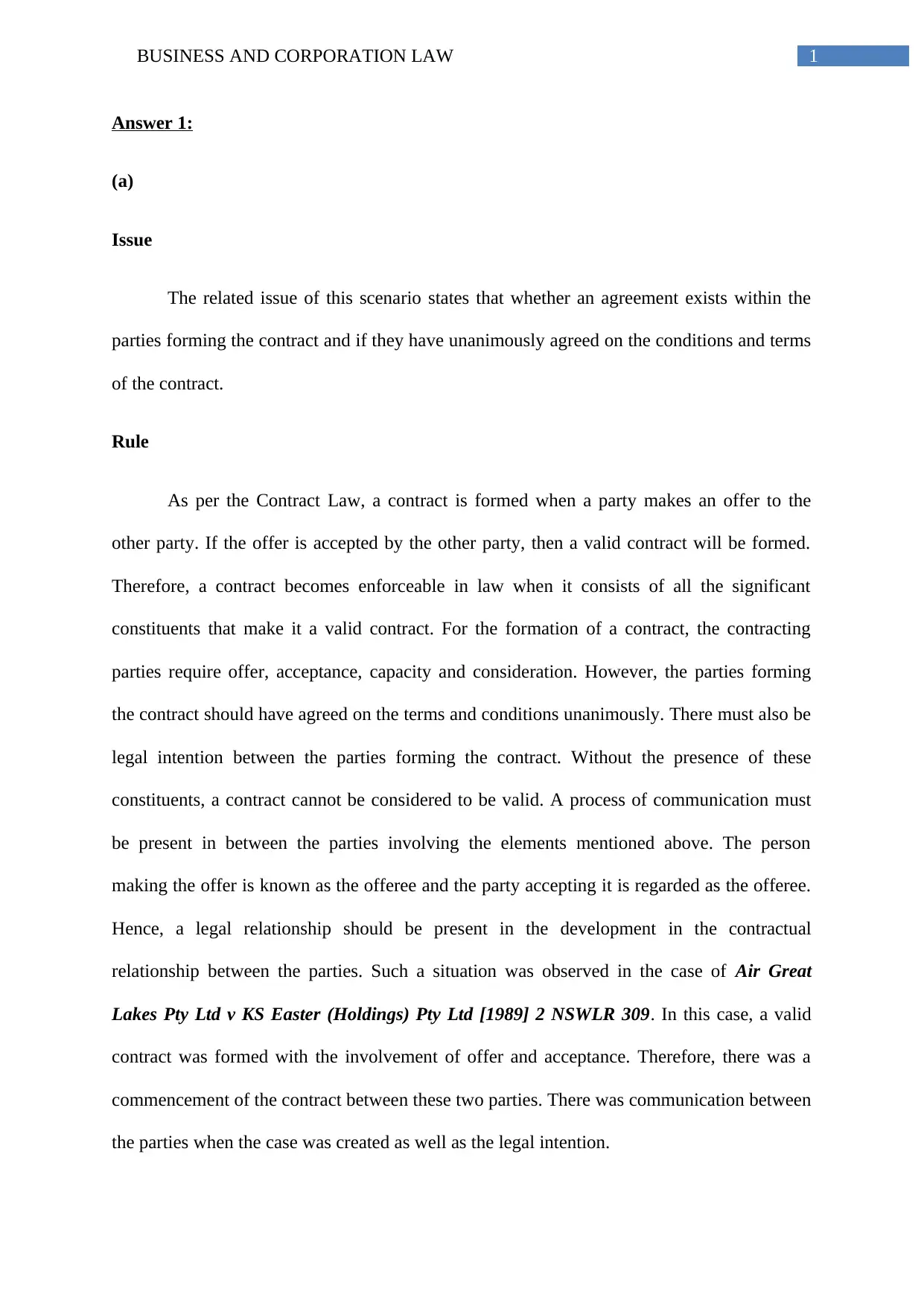
1BUSINESS AND CORPORATION LAW
Answer 1:
(a)
Issue
The related issue of this scenario states that whether an agreement exists within the
parties forming the contract and if they have unanimously agreed on the conditions and terms
of the contract.
Rule
As per the Contract Law, a contract is formed when a party makes an offer to the
other party. If the offer is accepted by the other party, then a valid contract will be formed.
Therefore, a contract becomes enforceable in law when it consists of all the significant
constituents that make it a valid contract. For the formation of a contract, the contracting
parties require offer, acceptance, capacity and consideration. However, the parties forming
the contract should have agreed on the terms and conditions unanimously. There must also be
legal intention between the parties forming the contract. Without the presence of these
constituents, a contract cannot be considered to be valid. A process of communication must
be present in between the parties involving the elements mentioned above. The person
making the offer is known as the offeree and the party accepting it is regarded as the offeree.
Hence, a legal relationship should be present in the development in the contractual
relationship between the parties. Such a situation was observed in the case of Air Great
Lakes Pty Ltd v KS Easter (Holdings) Pty Ltd [1989] 2 NSWLR 309. In this case, a valid
contract was formed with the involvement of offer and acceptance. Therefore, there was a
commencement of the contract between these two parties. There was communication between
the parties when the case was created as well as the legal intention.
Answer 1:
(a)
Issue
The related issue of this scenario states that whether an agreement exists within the
parties forming the contract and if they have unanimously agreed on the conditions and terms
of the contract.
Rule
As per the Contract Law, a contract is formed when a party makes an offer to the
other party. If the offer is accepted by the other party, then a valid contract will be formed.
Therefore, a contract becomes enforceable in law when it consists of all the significant
constituents that make it a valid contract. For the formation of a contract, the contracting
parties require offer, acceptance, capacity and consideration. However, the parties forming
the contract should have agreed on the terms and conditions unanimously. There must also be
legal intention between the parties forming the contract. Without the presence of these
constituents, a contract cannot be considered to be valid. A process of communication must
be present in between the parties involving the elements mentioned above. The person
making the offer is known as the offeree and the party accepting it is regarded as the offeree.
Hence, a legal relationship should be present in the development in the contractual
relationship between the parties. Such a situation was observed in the case of Air Great
Lakes Pty Ltd v KS Easter (Holdings) Pty Ltd [1989] 2 NSWLR 309. In this case, a valid
contract was formed with the involvement of offer and acceptance. Therefore, there was a
commencement of the contract between these two parties. There was communication between
the parties when the case was created as well as the legal intention.

2BUSINESS AND CORPORATION LAW
For the determination of validity of an offer, it should be accepted depending on the
specifications of the offer. There should not be any kind of alterations in the contract and if it
is present then it will be known as a counter offer. This scenario was observed in the case of
Balfour v Balfour [1919] 2 KB 571. Any offer formed or created should not result in a
counter-offer between the parties. Therefore, such kind of contract cannot be created.
In the case of AGC (Advances) Ltd v McWhirter (1977) 1 BLR 9454 it was observed
that the individual who is making the offer should communicate it properly to the offeree.
This results in the concept of invitation to treat. Therefore, such kind of a contract cannot be
considered to be a valid contract. In the matter of Australian Woollen Mills Pty Ltd v The
Commonwealth (1954) 92 CLR 424 the Court held and decided that there was no valid
contract between the parties. The offer that was made in the form of an advertisement was
treated to be an unilateral offer.
Application
From the given facts of the case scenario, it was observed that the painting of Magda
was put up for sale in her own website. The case of Australian Woollen Mills Pty Ltd v The
Commonwealth had a similar scenario where the advertisement was not treated to be an
invitation to treat. Avinash wanted to purchase that painting and made an offer of $1600 on
19th February. If the case of Air Great Lakes Pty Ltd v KS Easter (Holdings) Pty Ltd is
applied in this scenario then a valid offer was made by Avinash since it contained a legal
intention to the contractual terms for the purpose of binding the parties.
Thereafter, a counter-offer was formed or made by Avinash on 20th February. The
counter-offer stated that there was a demand of an authenticity certificate. The certificate
however, did not amount in paying the request for the required information and neither any
kind of inquiry. The case mentioned above also stated that an offer was thereafter made
For the determination of validity of an offer, it should be accepted depending on the
specifications of the offer. There should not be any kind of alterations in the contract and if it
is present then it will be known as a counter offer. This scenario was observed in the case of
Balfour v Balfour [1919] 2 KB 571. Any offer formed or created should not result in a
counter-offer between the parties. Therefore, such kind of contract cannot be created.
In the case of AGC (Advances) Ltd v McWhirter (1977) 1 BLR 9454 it was observed
that the individual who is making the offer should communicate it properly to the offeree.
This results in the concept of invitation to treat. Therefore, such kind of a contract cannot be
considered to be a valid contract. In the matter of Australian Woollen Mills Pty Ltd v The
Commonwealth (1954) 92 CLR 424 the Court held and decided that there was no valid
contract between the parties. The offer that was made in the form of an advertisement was
treated to be an unilateral offer.
Application
From the given facts of the case scenario, it was observed that the painting of Magda
was put up for sale in her own website. The case of Australian Woollen Mills Pty Ltd v The
Commonwealth had a similar scenario where the advertisement was not treated to be an
invitation to treat. Avinash wanted to purchase that painting and made an offer of $1600 on
19th February. If the case of Air Great Lakes Pty Ltd v KS Easter (Holdings) Pty Ltd is
applied in this scenario then a valid offer was made by Avinash since it contained a legal
intention to the contractual terms for the purpose of binding the parties.
Thereafter, a counter-offer was formed or made by Avinash on 20th February. The
counter-offer stated that there was a demand of an authenticity certificate. The certificate
however, did not amount in paying the request for the required information and neither any
kind of inquiry. The case mentioned above also stated that an offer was thereafter made
⊘ This is a preview!⊘
Do you want full access?
Subscribe today to unlock all pages.

Trusted by 1+ million students worldwide

3BUSINESS AND CORPORATION LAW
between the contracting parties. However, an offer of $1800 was made by Magda for the
painting. Thereafter, it resulted in an counter-offer since the original offer made by Avinash
was terminated. Based on the case of Balfour v Balfour, an additional condition of
consultation was offered with his wife regarding the purchase of the painting. Hence, a valid
contract was formed between these parties and it was only considered to be valid till 21st
February. The offer was therefore revoked by Magda that was until 21st February and it was
thereafter altered to 20th February. Avinash was informed regarding the modifications but it
lapsed based on the ground of time prior as per the acceptance which was made by Avinash.
Thus, no contract was created between Magda and Avinash.
Conclusion
It can therefore be concluded stating that Avinash and Magda did not form a contract
because of non-acceptance which resulted in revocation of the original contract.
Answer 1:
(b)
Issue
The issue in this scenario is whether Elton will be entitled for any of the rights as
mentioned in the Australian Consumer Law [ACL], (schedule 2) of the Australian
Competition and Consumer Act 2010 (Cth).
Rule
The Australian Consumer Law, states that an individual will be treated to be a
consumer of Australia only if the individual has fulfilled all the conditions levied under the
legal provisions according to section 3 of the above mentioned act. Firstly, the amount paid
between the contracting parties. However, an offer of $1800 was made by Magda for the
painting. Thereafter, it resulted in an counter-offer since the original offer made by Avinash
was terminated. Based on the case of Balfour v Balfour, an additional condition of
consultation was offered with his wife regarding the purchase of the painting. Hence, a valid
contract was formed between these parties and it was only considered to be valid till 21st
February. The offer was therefore revoked by Magda that was until 21st February and it was
thereafter altered to 20th February. Avinash was informed regarding the modifications but it
lapsed based on the ground of time prior as per the acceptance which was made by Avinash.
Thus, no contract was created between Magda and Avinash.
Conclusion
It can therefore be concluded stating that Avinash and Magda did not form a contract
because of non-acceptance which resulted in revocation of the original contract.
Answer 1:
(b)
Issue
The issue in this scenario is whether Elton will be entitled for any of the rights as
mentioned in the Australian Consumer Law [ACL], (schedule 2) of the Australian
Competition and Consumer Act 2010 (Cth).
Rule
The Australian Consumer Law, states that an individual will be treated to be a
consumer of Australia only if the individual has fulfilled all the conditions levied under the
legal provisions according to section 3 of the above mentioned act. Firstly, the amount paid
Paraphrase This Document
Need a fresh take? Get an instant paraphrase of this document with our AI Paraphraser

4BUSINESS AND CORPORATION LAW
for the products and services should not cross the amount of $40000. Secondly, the individual
has purchased any vehicle for transportation (Macaulay 2018). Thirdly, the services and
products purchased are for the use of household. Fourthly, the goods that have been
purchased are not used for resupplying.
In the case of Australian Competition and Consumer Commission v Hewlett-
Packard Australia Pty Ltd [2013] FCA 653, the Court had held that a customer is protected
as per the guarantees of the consumer in the circumstances where the seller had committed a
conduct that had caused damage to the consumers. The information that was provided by the
product was misleading and created a confusion and misunderstanding between the
consumers. It was not accurate and hence caused the customers to rely on the information
provided.
Thereafter, as per Section 18 of the Australian Consumer Law, from committing any
kind of conduct or omission while doing the business, the seller can be prevented. The
misleading nature can deceive the consumers of the product. Thereafter, Section 56 of the
Australian Consumer Law helps in providing guarantee to all the existing customers of
Australia. Every seller associated should make sure that the goods or services that ate
consumed by the customers must match the definition of the products that were stated by the
customers. According to the Section 260 of the Australian Consumer Law, a claim can be
filed by an aggrieved consumer for getting a refund against the infringing the party (Davies
2018). The seller must be held liable for any kind of damage that was suffered by the
customer as it was provided. The consumer will therefore be held liable for the loss.
Application
From the facts of the scenario, Magda had sold the portrait painting to Elton and it
was therefore printed on a paper of high quality. Since the painting was put up on the
for the products and services should not cross the amount of $40000. Secondly, the individual
has purchased any vehicle for transportation (Macaulay 2018). Thirdly, the services and
products purchased are for the use of household. Fourthly, the goods that have been
purchased are not used for resupplying.
In the case of Australian Competition and Consumer Commission v Hewlett-
Packard Australia Pty Ltd [2013] FCA 653, the Court had held that a customer is protected
as per the guarantees of the consumer in the circumstances where the seller had committed a
conduct that had caused damage to the consumers. The information that was provided by the
product was misleading and created a confusion and misunderstanding between the
consumers. It was not accurate and hence caused the customers to rely on the information
provided.
Thereafter, as per Section 18 of the Australian Consumer Law, from committing any
kind of conduct or omission while doing the business, the seller can be prevented. The
misleading nature can deceive the consumers of the product. Thereafter, Section 56 of the
Australian Consumer Law helps in providing guarantee to all the existing customers of
Australia. Every seller associated should make sure that the goods or services that ate
consumed by the customers must match the definition of the products that were stated by the
customers. According to the Section 260 of the Australian Consumer Law, a claim can be
filed by an aggrieved consumer for getting a refund against the infringing the party (Davies
2018). The seller must be held liable for any kind of damage that was suffered by the
customer as it was provided. The consumer will therefore be held liable for the loss.
Application
From the facts of the scenario, Magda had sold the portrait painting to Elton and it
was therefore printed on a paper of high quality. Since the painting was put up on the
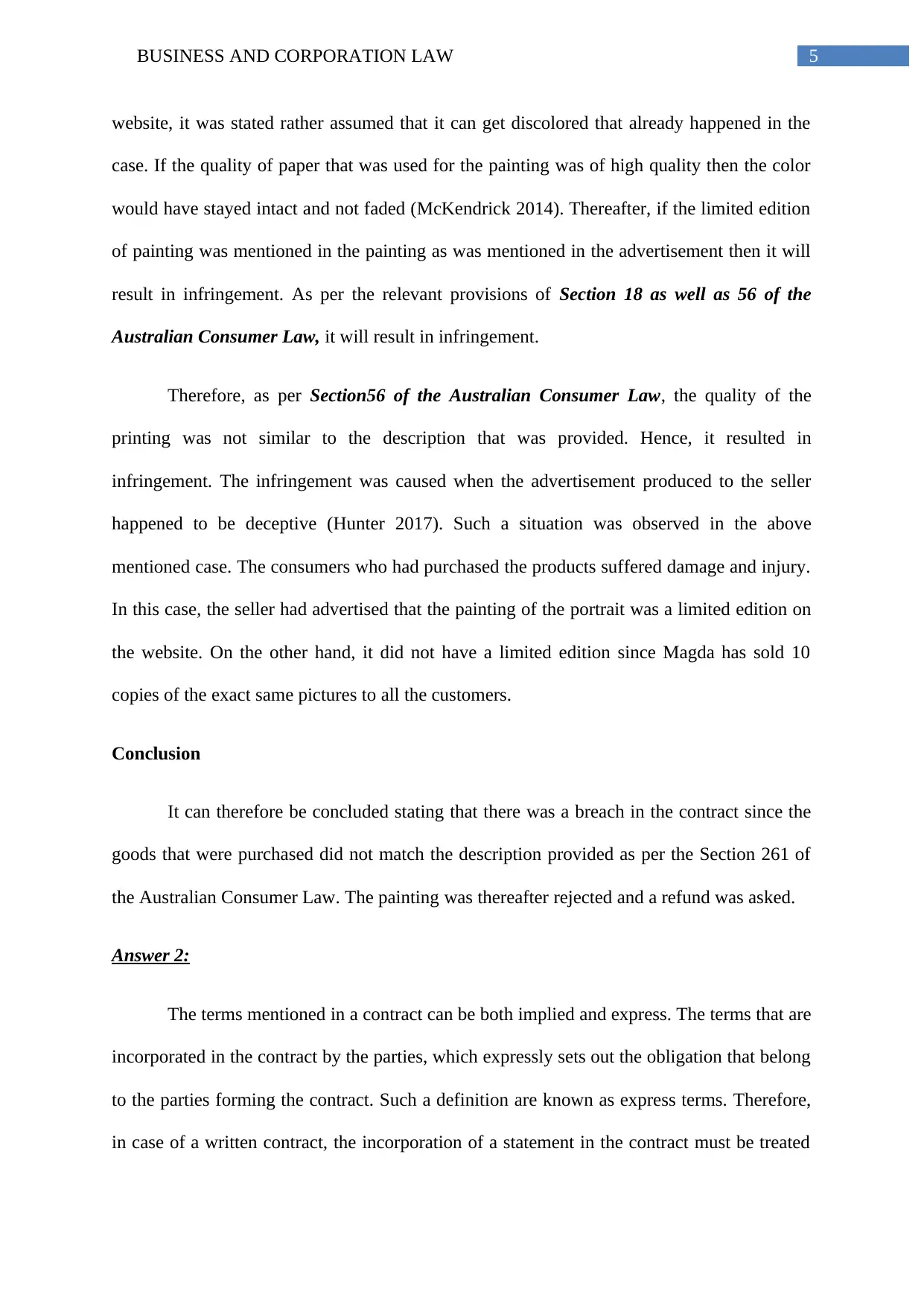
5BUSINESS AND CORPORATION LAW
website, it was stated rather assumed that it can get discolored that already happened in the
case. If the quality of paper that was used for the painting was of high quality then the color
would have stayed intact and not faded (McKendrick 2014). Thereafter, if the limited edition
of painting was mentioned in the painting as was mentioned in the advertisement then it will
result in infringement. As per the relevant provisions of Section 18 as well as 56 of the
Australian Consumer Law, it will result in infringement.
Therefore, as per Section56 of the Australian Consumer Law, the quality of the
printing was not similar to the description that was provided. Hence, it resulted in
infringement. The infringement was caused when the advertisement produced to the seller
happened to be deceptive (Hunter 2017). Such a situation was observed in the above
mentioned case. The consumers who had purchased the products suffered damage and injury.
In this case, the seller had advertised that the painting of the portrait was a limited edition on
the website. On the other hand, it did not have a limited edition since Magda has sold 10
copies of the exact same pictures to all the customers.
Conclusion
It can therefore be concluded stating that there was a breach in the contract since the
goods that were purchased did not match the description provided as per the Section 261 of
the Australian Consumer Law. The painting was thereafter rejected and a refund was asked.
Answer 2:
The terms mentioned in a contract can be both implied and express. The terms that are
incorporated in the contract by the parties, which expressly sets out the obligation that belong
to the parties forming the contract. Such a definition are known as express terms. Therefore,
in case of a written contract, the incorporation of a statement in the contract must be treated
website, it was stated rather assumed that it can get discolored that already happened in the
case. If the quality of paper that was used for the painting was of high quality then the color
would have stayed intact and not faded (McKendrick 2014). Thereafter, if the limited edition
of painting was mentioned in the painting as was mentioned in the advertisement then it will
result in infringement. As per the relevant provisions of Section 18 as well as 56 of the
Australian Consumer Law, it will result in infringement.
Therefore, as per Section56 of the Australian Consumer Law, the quality of the
printing was not similar to the description that was provided. Hence, it resulted in
infringement. The infringement was caused when the advertisement produced to the seller
happened to be deceptive (Hunter 2017). Such a situation was observed in the above
mentioned case. The consumers who had purchased the products suffered damage and injury.
In this case, the seller had advertised that the painting of the portrait was a limited edition on
the website. On the other hand, it did not have a limited edition since Magda has sold 10
copies of the exact same pictures to all the customers.
Conclusion
It can therefore be concluded stating that there was a breach in the contract since the
goods that were purchased did not match the description provided as per the Section 261 of
the Australian Consumer Law. The painting was thereafter rejected and a refund was asked.
Answer 2:
The terms mentioned in a contract can be both implied and express. The terms that are
incorporated in the contract by the parties, which expressly sets out the obligation that belong
to the parties forming the contract. Such a definition are known as express terms. Therefore,
in case of a written contract, the incorporation of a statement in the contract must be treated
⊘ This is a preview!⊘
Do you want full access?
Subscribe today to unlock all pages.

Trusted by 1+ million students worldwide
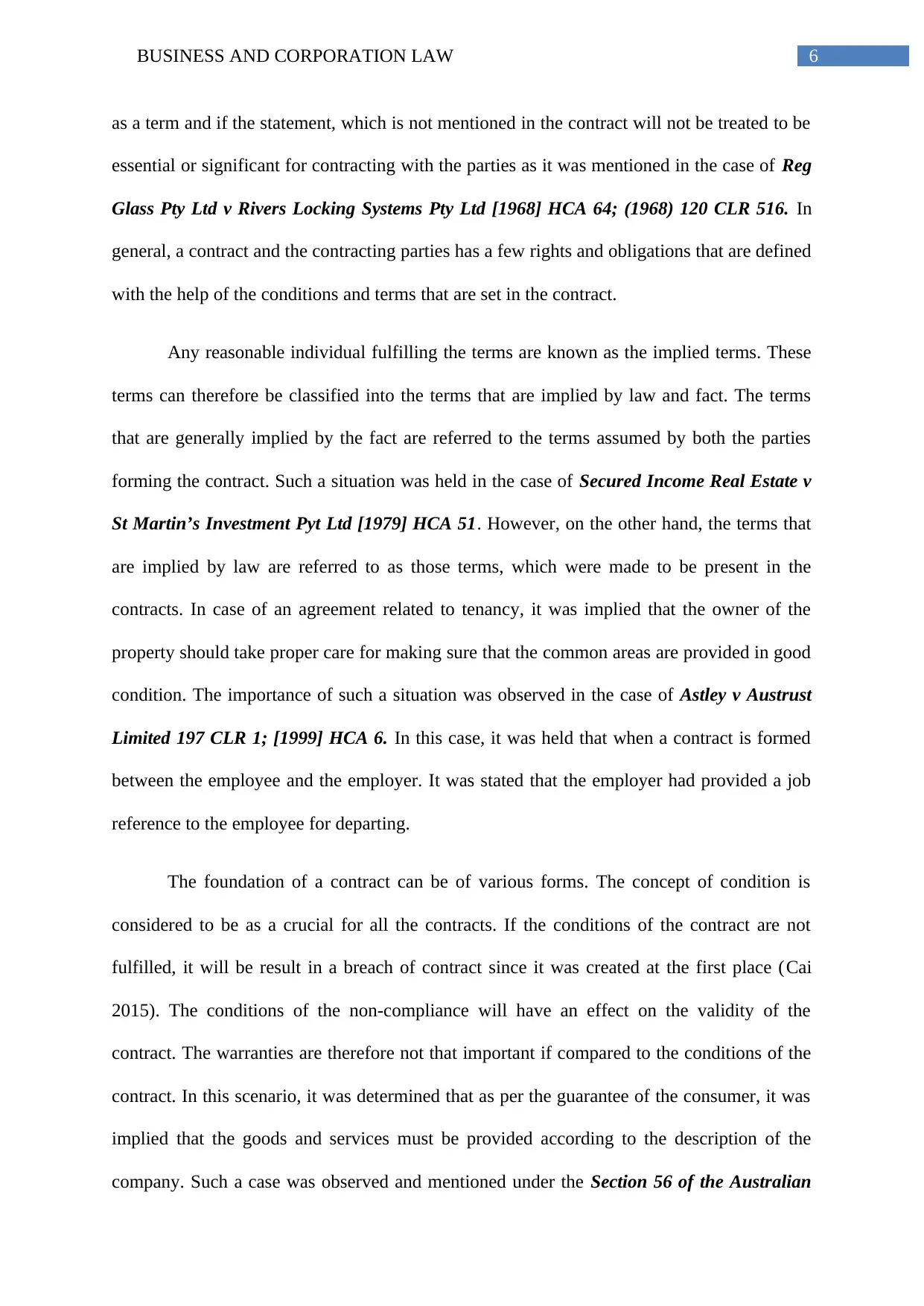
6BUSINESS AND CORPORATION LAW
as a term and if the statement, which is not mentioned in the contract will not be treated to be
essential or significant for contracting with the parties as it was mentioned in the case of Reg
Glass Pty Ltd v Rivers Locking Systems Pty Ltd [1968] HCA 64; (1968) 120 CLR 516. In
general, a contract and the contracting parties has a few rights and obligations that are defined
with the help of the conditions and terms that are set in the contract.
Any reasonable individual fulfilling the terms are known as the implied terms. These
terms can therefore be classified into the terms that are implied by law and fact. The terms
that are generally implied by the fact are referred to the terms assumed by both the parties
forming the contract. Such a situation was held in the case of Secured Income Real Estate v
St Martin’s Investment Pyt Ltd [1979] HCA 51. However, on the other hand, the terms that
are implied by law are referred to as those terms, which were made to be present in the
contracts. In case of an agreement related to tenancy, it was implied that the owner of the
property should take proper care for making sure that the common areas are provided in good
condition. The importance of such a situation was observed in the case of Astley v Austrust
Limited 197 CLR 1; [1999] HCA 6. In this case, it was held that when a contract is formed
between the employee and the employer. It was stated that the employer had provided a job
reference to the employee for departing.
The foundation of a contract can be of various forms. The concept of condition is
considered to be as a crucial for all the contracts. If the conditions of the contract are not
fulfilled, it will be result in a breach of contract since it was created at the first place (Cai
2015). The conditions of the non-compliance will have an effect on the validity of the
contract. The warranties are therefore not that important if compared to the conditions of the
contract. In this scenario, it was determined that as per the guarantee of the consumer, it was
implied that the goods and services must be provided according to the description of the
company. Such a case was observed and mentioned under the Section 56 of the Australian
as a term and if the statement, which is not mentioned in the contract will not be treated to be
essential or significant for contracting with the parties as it was mentioned in the case of Reg
Glass Pty Ltd v Rivers Locking Systems Pty Ltd [1968] HCA 64; (1968) 120 CLR 516. In
general, a contract and the contracting parties has a few rights and obligations that are defined
with the help of the conditions and terms that are set in the contract.
Any reasonable individual fulfilling the terms are known as the implied terms. These
terms can therefore be classified into the terms that are implied by law and fact. The terms
that are generally implied by the fact are referred to the terms assumed by both the parties
forming the contract. Such a situation was held in the case of Secured Income Real Estate v
St Martin’s Investment Pyt Ltd [1979] HCA 51. However, on the other hand, the terms that
are implied by law are referred to as those terms, which were made to be present in the
contracts. In case of an agreement related to tenancy, it was implied that the owner of the
property should take proper care for making sure that the common areas are provided in good
condition. The importance of such a situation was observed in the case of Astley v Austrust
Limited 197 CLR 1; [1999] HCA 6. In this case, it was held that when a contract is formed
between the employee and the employer. It was stated that the employer had provided a job
reference to the employee for departing.
The foundation of a contract can be of various forms. The concept of condition is
considered to be as a crucial for all the contracts. If the conditions of the contract are not
fulfilled, it will be result in a breach of contract since it was created at the first place (Cai
2015). The conditions of the non-compliance will have an effect on the validity of the
contract. The warranties are therefore not that important if compared to the conditions of the
contract. In this scenario, it was determined that as per the guarantee of the consumer, it was
implied that the goods and services must be provided according to the description of the
company. Such a case was observed and mentioned under the Section 56 of the Australian
Paraphrase This Document
Need a fresh take? Get an instant paraphrase of this document with our AI Paraphraser
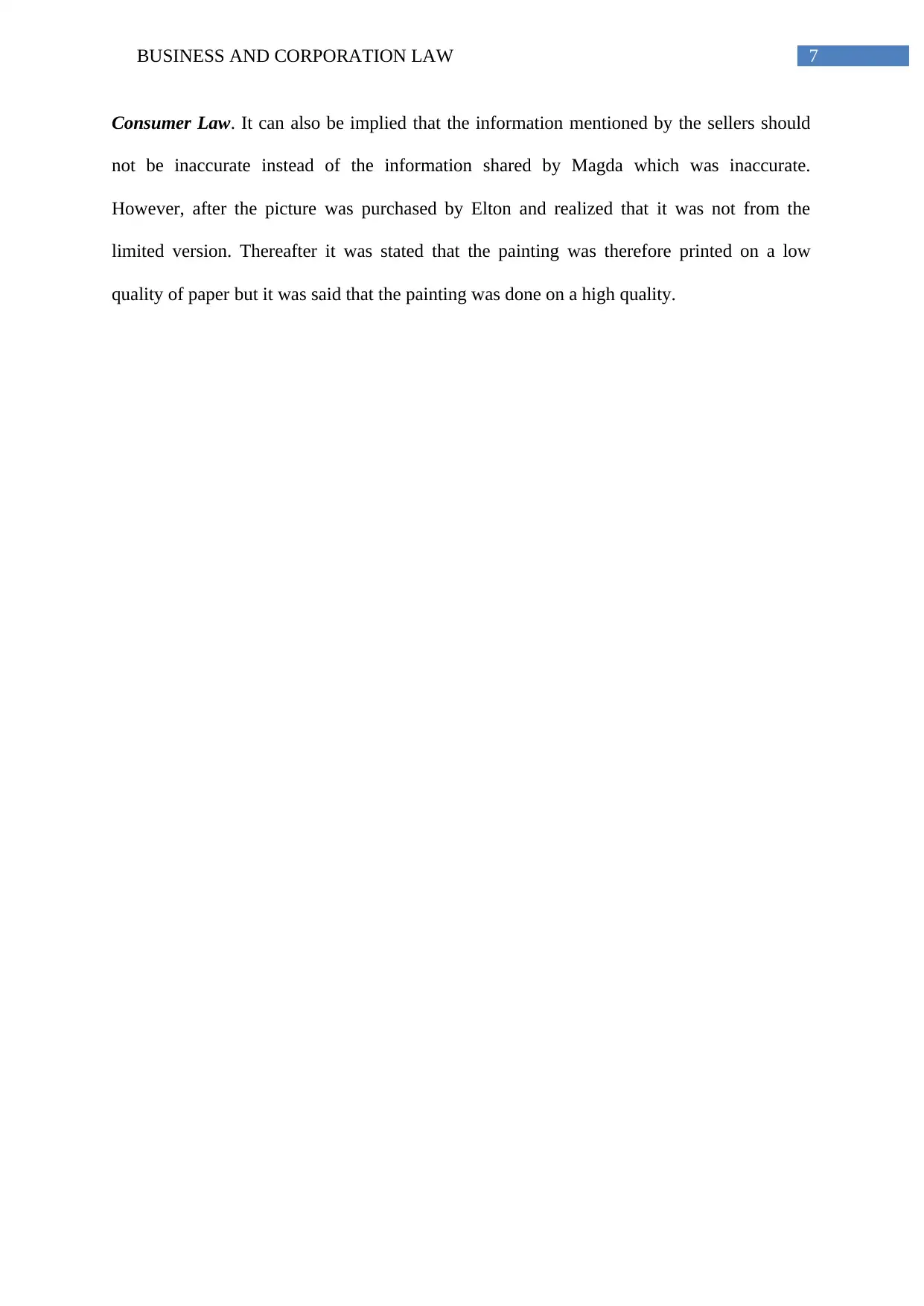
7BUSINESS AND CORPORATION LAW
Consumer Law. It can also be implied that the information mentioned by the sellers should
not be inaccurate instead of the information shared by Magda which was inaccurate.
However, after the picture was purchased by Elton and realized that it was not from the
limited version. Thereafter it was stated that the painting was therefore printed on a low
quality of paper but it was said that the painting was done on a high quality.
Consumer Law. It can also be implied that the information mentioned by the sellers should
not be inaccurate instead of the information shared by Magda which was inaccurate.
However, after the picture was purchased by Elton and realized that it was not from the
limited version. Thereafter it was stated that the painting was therefore printed on a low
quality of paper but it was said that the painting was done on a high quality.

8BUSINESS AND CORPORATION LAW
References:
Cases:
Air Great Lakes Pty Ltd v KS Easter (Holdings) Pty Ltd
Astley v Austrust Limited 197 CLR 1; [1999] HCA 6
Australian Competition and Consumer Commission v Hewlett-Packard Australia Pty Ltd
[2013] FCA 653
Australian Woollen Mills Pty Ltd v The Commonwealth
Balfour v Balfour [1919] 2 KB 571
Reg Glass Pty Ltd v Rivers Locking Systems Pty Ltd [1968] HCA 64; (1968) 120 CLR 516
Secured Income Real Estate v St Martin’s Investment Pyt Ltd [1979] HCA 51
Balfour v Balfour [1919] 2 KB 571
Journals:
Cai, W., 2015. The Relationship between a Duty of Good Faith and Implied Terms in English
Contract Law. Exeter Student L. Rev., 1, p.1.
Davies, P.S., 2018. CONTRACT FORMATION AND IMPLIED TERMS. The Cambridge
Law Journal, 77(1), pp.22-25.
Hunter, H., 2017. Modern Law of Contracts.
Knapp, C.L., Crystal, N.M. and Prince, H.G., 2016. Problems in Contract Law: cases and
materials. Wolters Kluwer Law & Business.
References:
Cases:
Air Great Lakes Pty Ltd v KS Easter (Holdings) Pty Ltd
Astley v Austrust Limited 197 CLR 1; [1999] HCA 6
Australian Competition and Consumer Commission v Hewlett-Packard Australia Pty Ltd
[2013] FCA 653
Australian Woollen Mills Pty Ltd v The Commonwealth
Balfour v Balfour [1919] 2 KB 571
Reg Glass Pty Ltd v Rivers Locking Systems Pty Ltd [1968] HCA 64; (1968) 120 CLR 516
Secured Income Real Estate v St Martin’s Investment Pyt Ltd [1979] HCA 51
Balfour v Balfour [1919] 2 KB 571
Journals:
Cai, W., 2015. The Relationship between a Duty of Good Faith and Implied Terms in English
Contract Law. Exeter Student L. Rev., 1, p.1.
Davies, P.S., 2018. CONTRACT FORMATION AND IMPLIED TERMS. The Cambridge
Law Journal, 77(1), pp.22-25.
Hunter, H., 2017. Modern Law of Contracts.
Knapp, C.L., Crystal, N.M. and Prince, H.G., 2016. Problems in Contract Law: cases and
materials. Wolters Kluwer Law & Business.
⊘ This is a preview!⊘
Do you want full access?
Subscribe today to unlock all pages.

Trusted by 1+ million students worldwide
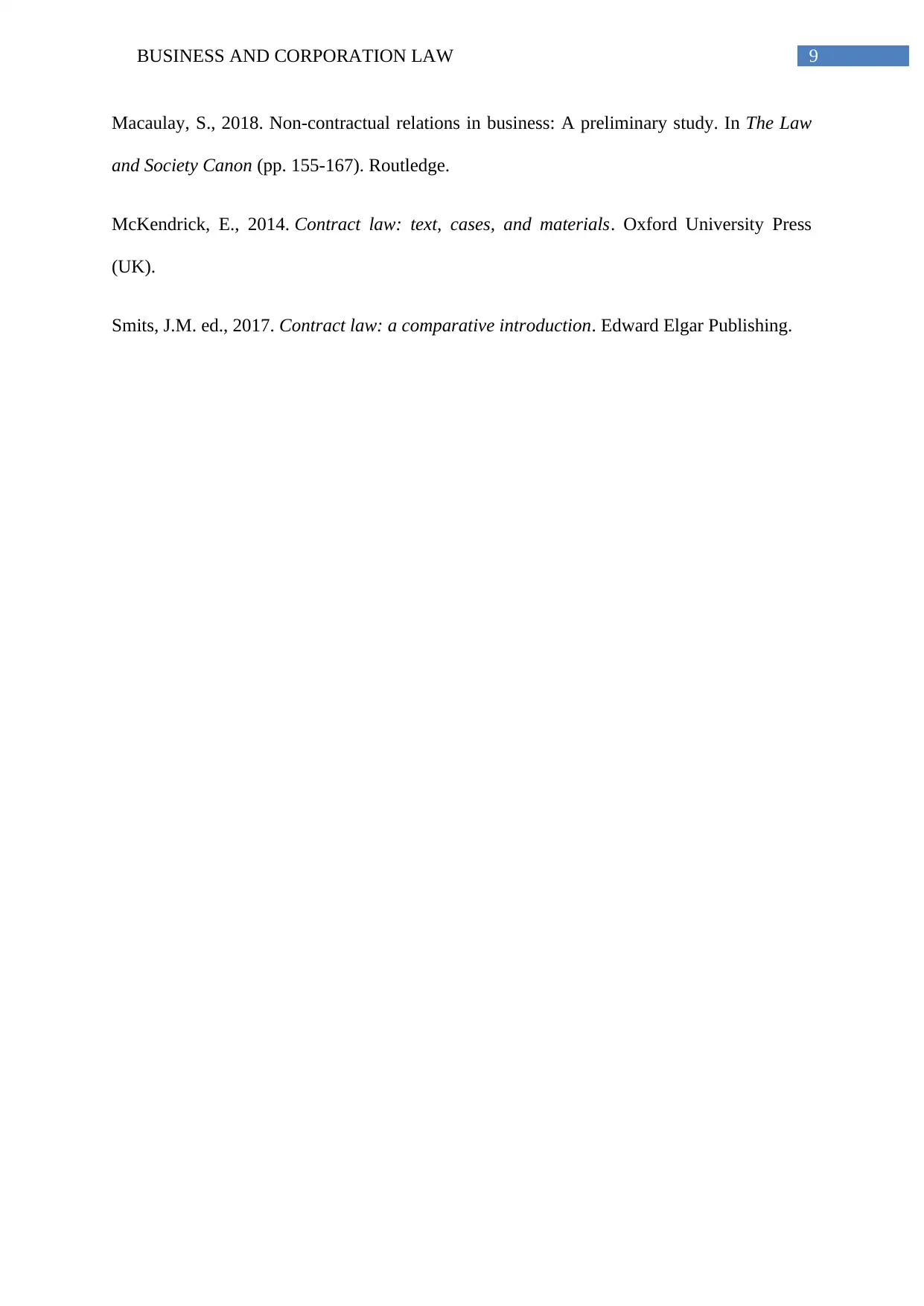
9BUSINESS AND CORPORATION LAW
Macaulay, S., 2018. Non-contractual relations in business: A preliminary study. In The Law
and Society Canon (pp. 155-167). Routledge.
McKendrick, E., 2014. Contract law: text, cases, and materials. Oxford University Press
(UK).
Smits, J.M. ed., 2017. Contract law: a comparative introduction. Edward Elgar Publishing.
Macaulay, S., 2018. Non-contractual relations in business: A preliminary study. In The Law
and Society Canon (pp. 155-167). Routledge.
McKendrick, E., 2014. Contract law: text, cases, and materials. Oxford University Press
(UK).
Smits, J.M. ed., 2017. Contract law: a comparative introduction. Edward Elgar Publishing.
1 out of 10
Related Documents
Your All-in-One AI-Powered Toolkit for Academic Success.
+13062052269
info@desklib.com
Available 24*7 on WhatsApp / Email
![[object Object]](/_next/static/media/star-bottom.7253800d.svg)
Unlock your academic potential
Copyright © 2020–2025 A2Z Services. All Rights Reserved. Developed and managed by ZUCOL.




